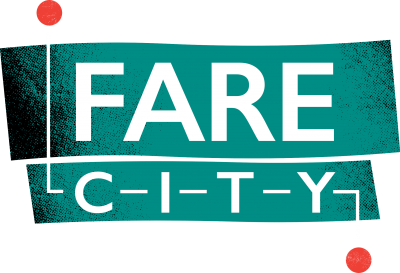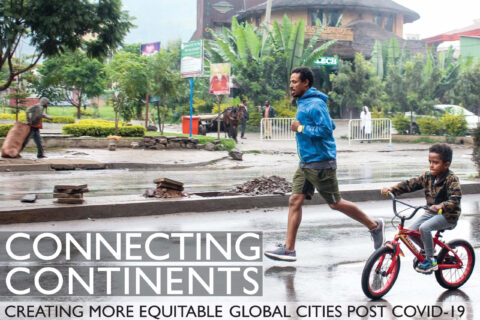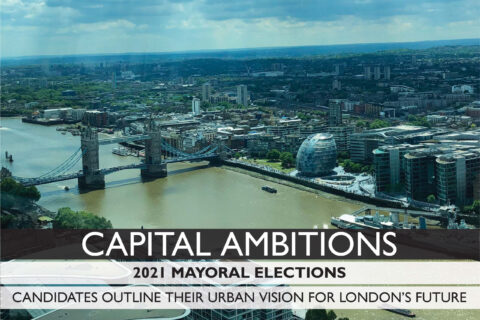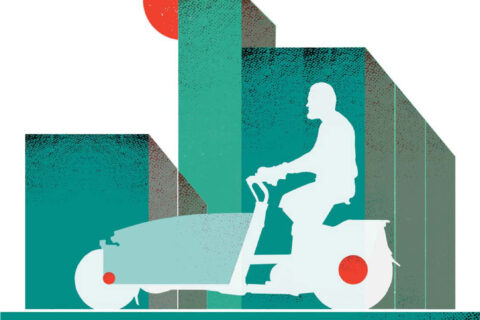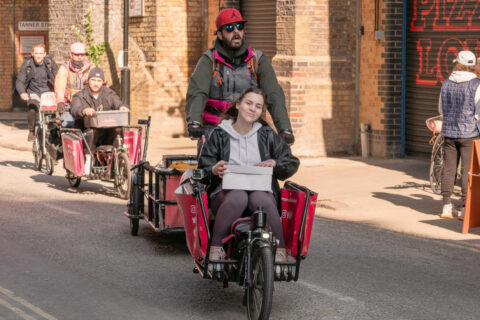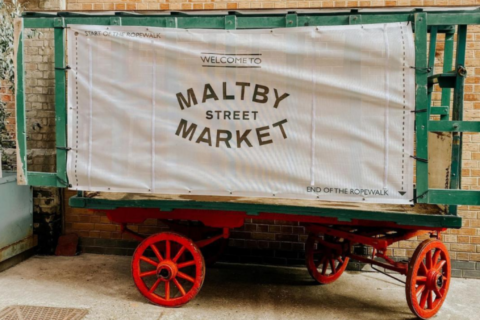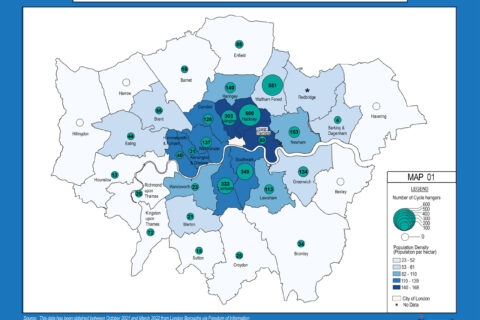Hammersmith Bridge has been closed to motorised vehicles since April 2019, this is after engineers discovered hairline micro-fractures to the bridges main structure. Fare City have since conducted a public survey on the bridge, which took place between Monday 19.8.19 and Thursday 22.8.19. The survey asked members of the public about their views on the part closure, whether they thought the part closure had any benefits and what their preference for the future use of the bridge was.
Methodology
Respondents were asked questions which aimed to establish:
- How often respondents cross the bridge
- How respondents were crossing the bridge before its closure to motorised vehicles
- Whether respondents consider the closure of the bridge to motorised vehicles to have any benefits
- How respondents think the bridge could be used in the future
- Whether respondents can see any benefit for the use of the bridge as a community market, one day a month
This research has been carried out by, and on behalf of, Fare City. A pilot survey preceded the main survey, with adjustments being made to the questionnaire as required. The survey was carried out on the bridge at different times of the day, over four consecutive days, and was conducted by the same interviewer. The survey responses were then analysed by the Fare City team. This has been done on an anonymous basis, and in accordance with the guidelines of the Data Protection Act 2018.
Respondents
| Total questionnaires carried out | 122 | ||
| Total survey respondents | 159 | (100%) | |
| Total male/female split | 74/85 | (47% / 53%) | |
| Total age split | |||
| 0 – 17 yo | 27 | (17%) | |
| 18 – 29 yo | 25 | (16%) | |
| 30 – 49 yo | 50 | (31%) | |
| 50 – 69 yo | 37 | (23%) | |
| 70+ yo | 20 | (13%) |

- One third of all respondents (33%) are aged 29 years or younger
Residence
| Borough of Richmond | 101 | (63%) |
| Borough of Hammersmith & Fulham | 20 | (13%) |
| Other/Don’t know | 38 | (24%) |
- 6 out of 10 respondents (63%) live in the Borough of Richmond
Q1: How often do you cross the bridge?
| All respondents | ||
| Daily | 80 | (50%) |
| Several times a week | 32 | (20%) |
| Once a week or less | 40 | (25%) |
| Other/Don’t know | 7 | (5%) |
- Half of all respondents (50%), cross the bridge every day
Q2: Before the closure of the bridge to motorised vehicles, how did you usually cross the bridge?
| All respondents | ||
| Walk | 52 | (33%) |
| Cycle | 6 | (4%) |
| Bus | 55 | (34%) |
| Car/Motorbike | 33 | (21%) |
| Other/Don’t Know | 13 | (8%) |
- A third of all respondents (33%), usually walked across the bridge
- A third of all respondents (34%), usually took a bus to cross the bridge
- One in five of all respondents (21%), usually used either a car or motorbike to cross the bridge
- A majority of all respondents (55%), usually used motorised transport to cross the bridge
Q3: Since the closure of the bridge to motorised vehicles, how do you usually cross the bridge?
| All respondents | Previously Car/Motorbike users (33) | |||
| Walk | 134 | (84%) | 26 | (79%) |
| Cycle | 18 | (11%) | 3 | (9%) |
| Bike (push) | 1 | (1%) | 1 | (3%) |
| Other/Don’t know | 6 | (4%) | 3 | (9%) |
- Over three quarters (79%), of all respondents who usually used a car or motorbike to cross the bridge, now usually cross the bridge on foot
Q4: Do you consider the closure of the bridge to motorised vehicles to have any benefits?
| All respondents | Age 29 and under | Age 70 and over | ||||
| Yes | 76 | (48%) | 25 | (48%) | 5 | (25%) |
| No | 66 | (41%) | 20 | (38%) | 11 | (55%) |
| Other/Don’t know | 17 | (11%) | 7 | (14%) | 4 | (20%) |
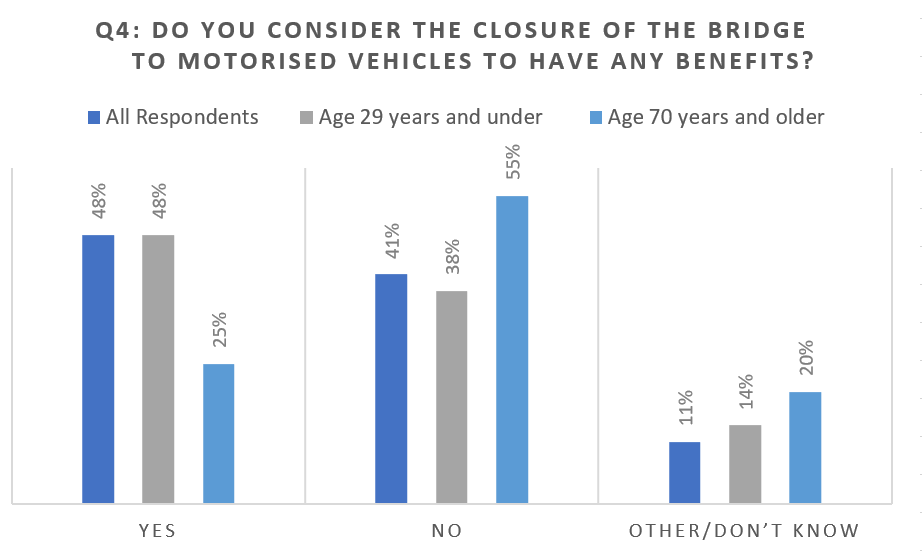
- A greater percentage of those surveyed (48%), consider the closure of the bridge to motorised vehicles to have some benefits
- A greater percentage of those surveyed aged 29 years and under (48%), consider the closure of the bridge to motorised vehicles to have some benefits
- The majority of those aged 70 years and over (55%), do not consider the closure of the bridge to motorised vehicles to have any benefits
What do you consider the biggest benefit to be?
Percentage of those who answered ‘Yes’ to Question 4
| All respondents | ||
| Improved air quality | 27 | (38%) |
| Increased sense of community | 1 | (1%) |
| Improved experience of crossing | 21 | (29%) |
| Improved safety | 2 | (3%) |
| Positive lifestyle change | 15 | (21%) |
| Other/Don’t know | 6 | (8%) |

- Over a third of all respondents (38%), who consider that the closure of the bridge to motorised vehicles has some benefits, cited improved air quality as being the biggest benefit
- One in five of all respondents (21%), who consider that the closure of the bridge to motorised vehicles has some benefits, identified that it had encouraged a positive lifestyle change
Q5: How do you think the bridge could be used in the future?
| All respondents | Age 29 and under | Age 70 and over | ||||
| Reopened to all modes of transport | 68 | (43%) | 21 | (40%) | 9 | (45%) |
| Reopened to public transport, cyclists and pedestrians only | 65 | (41%) | 25 | (48%) | 9 | (45%) |
| Reopened to cyclists and pedestrians only | 17 | (11%) | 5 | (10%) | 2 | (10%) |
| Permanently closed to transport and used as a new public space | 1 | (0%) | n/a | n/a | ||
| Closed to transport on certain days and used as a new public space | 3 | (2%) | n/a | n/a | ||
| Other/don’t know | 5 | (3%) | 1 | (2%) | n/a |
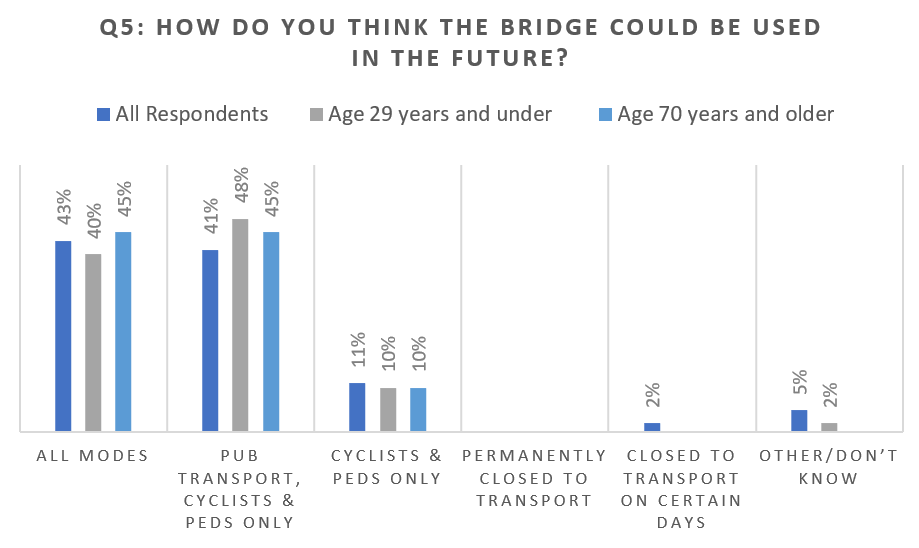
- Almost as many respondents (41%), believe that the bridge should be reopened to public transport, cyclists and pedestrians only, as those who believe it should be reopened as it was previously used (43%)
- A greater percentage of those surveyed aged 29 years and under (48%), believe that the bridge should be reopened to public transport, cyclists and pedestrians only
- One in ten (11%), of all respondents believe that the bridge should be reopened to cyclists and pedestrians only
Q6: Could you see any benefit for the use of the bridge as a community market, one day a month?
| All Respondents | 29 and under | 70 and over | ||||
| Yes | 120 | (76%) | 43 | (83%) | 10 | (50%) |
| No | 37 | (23%) | 7 | (13%) | 10 | (50%) |
| Other/don’t know | 2 | (1%) | 2 | (4%) | n/a |
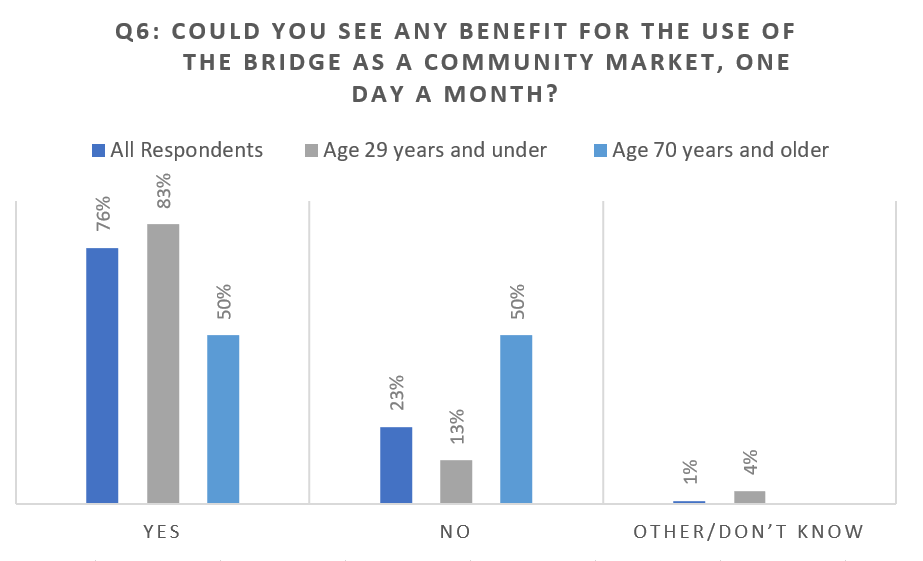
- Three quarters of all respondents (76%), consider that the use of the bridge as a community market, one day a month, would provide some benefit
- 8 out of 10 respondents (83%), aged 29 years or younger, consider that the use of the bridge as a community market, one day a month, would provide some benefit
Summary
The survey helped to identify a range of views, regarding both the current and future use of Hammersmith Bridge. Of all the findings the following three are the most interesting:
1.
A greater percentage of those surveyed (48%), consider the closure of the bridge to motorised vehicles to have some benefits
This statistic illustrates that respondents can see a clear benefit to the closure of the bridge to motorised vehicles. Those that answered ‘Don’t know/Other’, in almost all cases, explained that the positives as a result of the bridges closure were canceled out by the negatives, but they were unsure as to which was greater.
The fact that the majority of all respondents (55%), usually used a motorised vehicle to cross the bridge and are now crossing predominantly on foot, suggests that they are making more active travel choices. This does not factor in those respondents who are doing this out of necessity, or those who are finding alternative routes across the river.
FARE CITY is interested in understanding how these benefits, can be retained when the bridge is repaired and re-opened.
2.
Almost as many respondents (41%), believe that the bridge should be reopened to public transport, cyclists and pedestrians only, as those who believe it should be reopened as it was previously used (43%)
Hammersmith and Fulham Council have pledged to re-open the bridge to ‘full working order’, which means to all modes of transport as before the part closure. Whilst this is readily assumed to be the most desirous course of action, it only narrowly emerged as the single most preferable option amongst those surveyed.
In fact, a greater percentage of those surveyed aged 29 years and under (48%), believed that the bridge should be reopened to public transport, cyclists and pedestrians only. Conversations with young people on the bridge suggested that this result was influenced by several factors; including noise, safety and the link between car exhaust fumes and climate change.
FARE CITY will advocate that the bridge should be re-opened to public transport, cyclists and pedestrians only. However, there is a need to explore alternative modes of reliable, sustainable and high capacity public transport. This could form part of a wider strategic network, which if successfully realised may have the potential to encourage current car users to make the switch away from their vehicles.
3.
Three quarters of all respondents (76%), consider that the use of the bridge as a community market, one day a month, would provide some benefit
A large majority of respondents were supportive of the idea of re-appropriating the bridge as a community market. This would be held one day a month, once the bridge has been repaired and reopened. This majority rose to 83% amongst those aged 29 years and under, whilst the idea was neither supported nor rejected by those aged 70 years and older (both 50%).
FARE CITY believe that the Grade II* listed Hammersmith Bridge is a valuable heritage asset and should be celebrated by the local community. Re-appropriating the bridge as a community market would build upon the benefits identified by respondents, provide a new and unique public space and potentially unlock a new revenue stream for the local economy.
